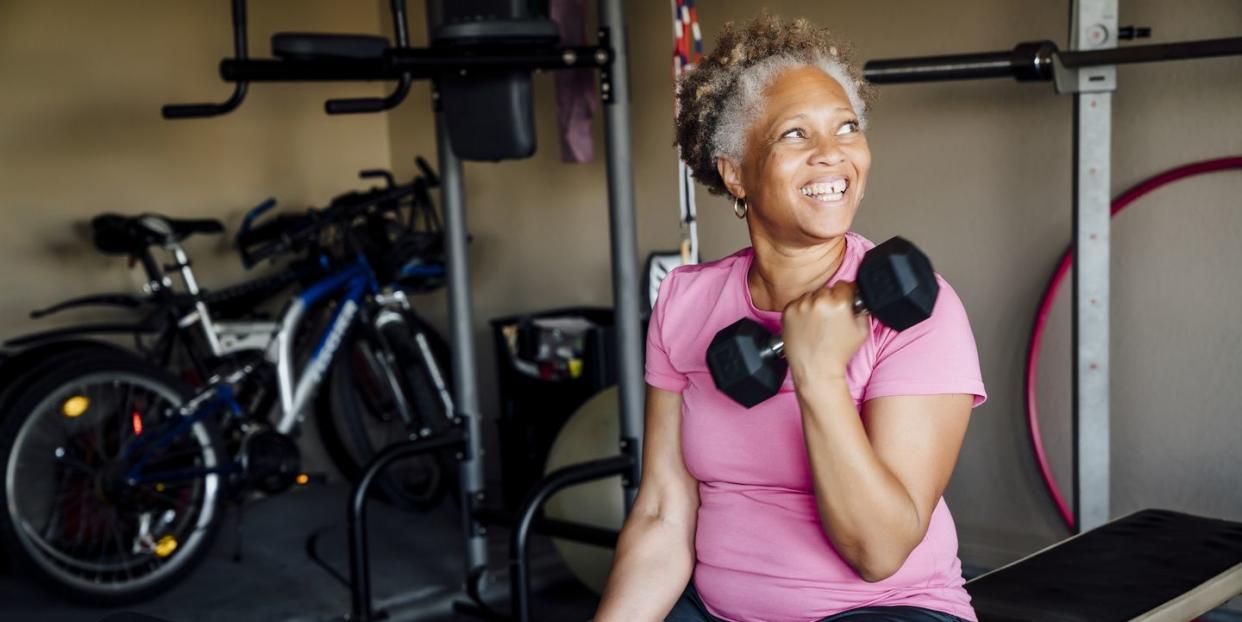How to Start Weight Training for Weight Loss, According to Trainers

"Hearst Magazines and Yahoo may earn commission or revenue on some items through these links."
Weight loss programs have long pushed intense cardio exercises as the single way to reach your goals. And for women especially, it was once taboo to venture away from the gym’s treadmill and elliptical stations. But that narrative is changing, and the reality is, weight training for weight loss can get you where you want to be, faster—and even make your results more sustainable, says Chad Barribeau, B.S., C.S.C.S., a field support director for D1 Training.
Keep reading to learn more about weight exercises for weight loss, including the best moves for beginners, must-have equipment, and how exactly pumping iron works to help you lose weight.
Why weight training for weight loss works
Weight training, also known as strength training or resistance training, is any exercise using weighted objects “like dumbbells, barbells, or weight machines” that increases muscle mass and strength, explains Amanda Capritto, C.P.T., ACE-certified personal trainer and writer at Garage Gym Reviews. You can also practice weight training using your own body weight.
Strength training aids weight loss by building muscle mass, which is more metabolically active than fat tissue, Capritto explains. The more muscle you build, the higher your resting metabolic rate rises, and “the more calories you can burn while you sleep, walk, work, or sit on the couch,” Capritto adds.
This perk isn’t one you’d get from cardio alone, because cardio burns calories solely by spiking the heart rate, forcing the cardiovascular system to work harder to supply blood and oxygen to working muscles. Still, “in a perfect world, you’re doing a little bit of both,” says Barribeau, to maintain good cardiovascular health.
As with any weight loss plan, diet should also be considered, but weight training is the way to go if you don’t plan to dramatically drop your calorie intake. That’s because muscle requires more calories to be maintained, Barribeau explains, so building it will naturally burn more calories and lead to weight loss.
Does weight training lead to “bulking up”?
The assumption that lifting weights automatically leads to “bulking up” or weight gain is a myth, says Barribeau. In fact, the growth spurt is actually way more difficult to achieve than most people realize.
“What most people don’t know is that ‘bulking’—or packing on a ton of muscle mass—is actually insanely difficult,” says Capritto. “It requires many hours in the weight room, eating a lot of calories and dialing in macronutrient ratios, and consistently performing near-maximal work. No one ‘bulks’ by lifting weights at moderate intensity three to four times a week.”
Barribeau adds that the only way to truly put on mass is by eating more calories than you’re burning off in a single day.
What weight training is best for weight loss?
“The best workout program for losing body fat includes both strength training and cardio,” says Capritto. “For weight training, you can use a barbell to train your upper body, lower body, and even your core.” She and Barribeau recommend starting with basics, such as:
Back squats (lifting the barbell behind the shoulders)
Front squats (lifting the barbell in front of the shoulders)
Romanian dead lifts
Hip thrusts
Overhead presses
Bench presses
Bent-over rows
If you don’t have access to a barbell, you can use dumbbells, a kettlebell, or your own body weight, simplified as compound exercises like:
Squats
Deadlifts
Push-ups
Planks
Hinges (i.e. kettlebell swings)
Rows
Pull-ups
Rest periods, Barribeau adds, are just as important as getting the movements in, as they affect how efficiently you burn calories. “We want to make sure that we’re working out proper work-to-rest ratios where we’re pushing ourselves without gassing ourselves out,” he says.
With that, he recommends starting with four sets of anywhere between eight to 12 reps of your chosen exercises, with around 90 seconds of rest between each set. “But depending on your endurance level and everything else, that could drop to as low as 60 seconds, or even be as high as about two minutes,” he adds.
Weight training for weight loss tips
While acclimating to your new routine, Barribeau can’t stress this enough: “Don’t rush it,” he says. “Be patient with it and be consistent.” Capritto recommdends taking two rest days per week, and remembering to make room for lifestyle and diet changes where necessary.
“While exercise is important for calorie burn, your diet plays a crucial role in weight loss and maintenance. Whether focusing on cardio or weight training, you should also pay attention to what you eat, get the right amount of sleep, hydrate adequately, and prioritize stress management,” she says.
Weight training for weight loss benefits
In addition to losing weight, Barribeau says strength training can also bring increased energy, decreased risk of injury, and improved flexibility and mobility. A lower body fat percentage, he says, can also reduce your risk of chronic disease and improve cardiovascular and mental health.
You Might Also Like

